Another barrier to the cloud which has been almost completely removed is concerns around security and bandwidth availability. “There’s been a huge adoption of people going to the cloud,” Madden claims. While the trend initially started with SMEs seeking to save costs, it has extended to the mid market. “We don’t see awful lot of people asking about where the data is,” he says. The low bandwidth issues which affected Office 365 and Exchange in the past have more or less been erased with the upgrading of exchanges.
Madden makes the point that although people have been wary of the cloud because of security or bandwidth concerns, they tend to dip their toe into it “with their most important application, which is e-mail”. While Exchange was probably the big thing for early adopters, other areas are becoming stronger. “Back up is huge now,” he says. “Cloud security is very large as well.”
As an early adopter of the cloud, MJ Flood bet fairly large on an Office 365 syndication partnership with O2 which has now extended to Telefonica UK. It’s worked out very well as MJ Flood has grown from 50 employees three years ago to 120 today with 40 of them solely supporting the syndication business. Madden claims Office 365b activation through MJ Flood is the highest in the world: “Normally, it’s around 30%, we are at 80%. It’s a great success for an Irish company to be able to deliver syndication services to other countries,” he adds.
Blended approach
Edel Creely, managing director of Trilogy Technologies, identifies the key to success with managed services as constantly doing things smarter and more efficiently while adding more services, such as security as a service and DRaaS, as you go along. “It’s about blending other services into the model and being able to provide them across multiple customers. It’s constantly evolving,” she says.
In the main, companies like Trilogy are talking about providing a catalogue of solutions and technologies. “It’s not any different than it was in the past, it’s just different technologies and different ways of delivering them,“ Creely remarks. “Customers still have a lot of choice and technologies and still need someone to advise them and bring it to them.”
Trilogy is involved with Office 365 and other solutions such as security services from cloud, which it can deliver as a managed services platform. “It’s about simplifying the solution for the client,” she argues, “where behind it there is obviously a lot of complexity. Technology changes all the time and new solutions become available.”
Within a catalogue of services, there are obviously certain ones businesses cannot be without. “There are a core set of services we would typically provide to most clients,” Creely says. “We’re managing and monitoring their core infrastructure and designing, architecting and delivering infrastructure for the customer.”
“It’s about blending other services into the model and being able to provide them across multiple customers” – Edel Creely, Trilogy
Organisations that want IT delivered as a service are looking to their internal IT people to add value to the business “by helping to deliver more value from the applications they’re delivering. Our value piece is to deliver on the management of the core infrastructure and free the business to deliver more value. Where the value of the managed service comes from is that we’re doing it more efficiently and more cost effectively. We have SLAs and we deliver on SLAs, we deliver that peace of the mind to the business.”
In 2013, Paul Kelly, country manager at ComputerLinks reported the managed services market was growing rapidly and quoted a report from Insight Research predicting it would enjoy double-digit rates unit 2017. One thing he didn’t predict (to us, anyway) was ComputerLinks’ acquisition by Arrow Electronics later that year.
Now rebranded as Arrow ECS (Enterprise Computing Solutions), director of strategy David Ellis observes that companies considering managed services are starting with data backup and disaster recovery (DR) because business continuity is top of the agenda for CIOs and CEOs.
“Resellers that can solve this pain point by offering flexible and scalable DR products and services alongside other core security solutions – such as antivirus protection and data loss prevention – will be best placed to take advantage of these throughout 2014,” he adds.








Subscribers 0
Fans 0
Followers 0
Followers